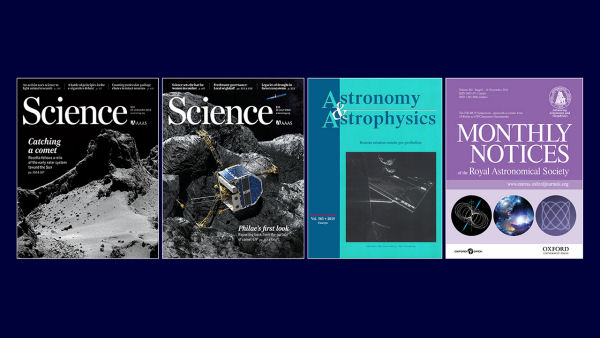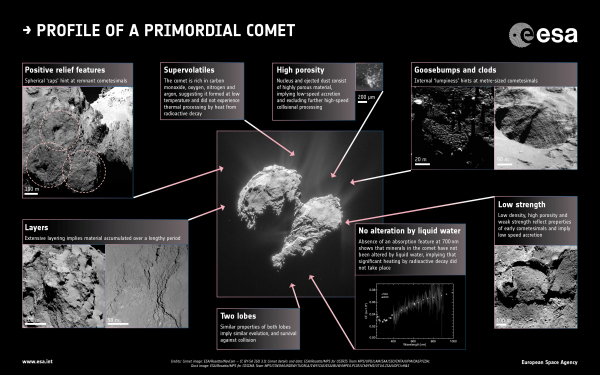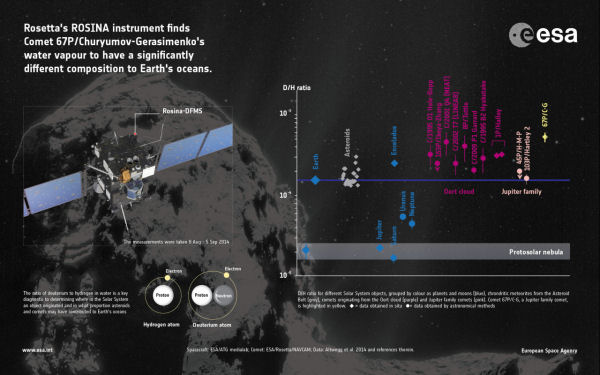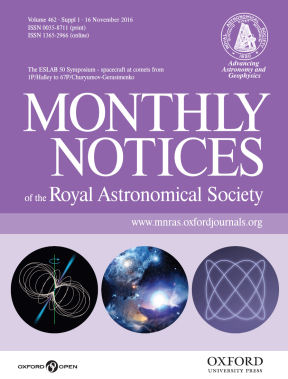Rosetta's intimate portrait of a comet: read all about it
4 April 2017
Rosetta's pioneering mission to explore a comet in unprecedented detail completed operations last year. As the science continues, members of the public, as well as scientists, can freely access hundreds of papers that reveal the comet's secrets. A special issue of Monthly Notices of the Royal Astronomical Society is the latest journal to provide this service. |
| These special issues of science journals provide free access to papers reporting Rosetta science. For credit details see here. |
Having delivered its small Philae lander to the comet's surface earlier in the mission, Rosetta ended its historic adventure with the 1.5 tonne spacecraft making an unprecedented touchdown on the comet's dark nucleus.
| Rosetta's journey around the comet, 1 August 2014 to 30 September 2016. For video details click here. Credit: ESA |
Before the intrepid explorer ceased transmitting, its 11 scientific instruments, together with the suite of instruments on board Philae, investigated every aspect of the comet's solid nucleus, its eruptive jets of gas and dust, and its interaction with interplanetary space. Data from the instruments have provided one surprise after another.
A wealth of discoveries
Even before Rosetta arrived at comet 67P/C-G on 6 August 2014, its cameras had revealed a rugged, double-lobed structure that was popularly compared to the shape of a rubber duck.
The surface, imaged in magnificent detail by the OSIRIS scientific camera and the NavCam navigation camera, displayed a wide range of landforms, including smooth plains, steep cliffs and pits that measured 100 metres wide and deep. Visible in the pit walls were 'goose bumps' about 3 metres in diameter.
To study the internal structure, the CONSERT experiment passed radio waves through the nucleus between the Philae lander and the orbiter. It showed that the 'head' of the comet is highly porous - consistent with a loosely compacted 'rubble pile' of dust and ice. Additional insight into the structure of the interior was provided by the Radio Science Investigation.
 |
| Profile of a primordial comet. For further details, including credits, click here. |
The Philae lander provided the 'ground truth' of the comet nucleus, revealing it to be devoid of a magnetic field, having a dusty surface with a harder, sintered subsurface, and a number of organic compounds and volatile molecules near the surface. The final resting place of Philae is a complex terrain, with fractures of varying scales and indications of ice deposits.
During Rosetta's approach to the comet in 2014, the MIRO instrument registered a 10-fold increase in the amount of water vapour being released by the comet over a period of only two months.
The characteristics of the comet's dust were pinned down by measurements from GIADA, COSIMA, and MIDAS. However, the ratio of dust to gas emitted by the nucleus showed that the comet is best described as an icy dust ball rather than a dirty snowball.
The VIRTIS instrument showed that, despite the icy composition of the nucleus, the surface was extremely dark as the result of a dusty coating. This was also the conclusion from observations made at far-ultraviolet wavelengths by the Alice instrument. Readings from the ROSINA instrument showed that the water making up the comet was substantially different from the water on Earth, indicating that our planet's oceans may not have been fed by incoming comets.
 |
| First measurements of comet 67P/C-G's water ratio. For further details, including credits, click here. |
ROSINA also discovered over 60 molecules, 34 of which had never been found before on a comet. These included the first detection of carbon dioxide on a comet.
Other instruments, in particular those of the Rosetta Plasma Consortium, studied how the outflowing gas in the coma interacted with the solar wind – a stream of charged particles continuously flowing from the Sun.
Data received from Rosetta and Philae is already rewriting the text books. Indeed, so much information was returned from the mission that it will take researchers many years to analyse it.
Sharing the scientific harvest
Matt Taylor, ESA's Rosetta Project Scientist, has been working with the international science teams in an effort to make their results available as quickly as possible to the wider community.
This has been made easier since the operational phase of the mission is over, because the teams can now focus on the mass of scientific data returned by Rosetta.
The teams have also been striving to have the scientific papers made available to the general public, as much as possible, through free access publications.
As a result, hundreds of articles and reports, based on the treasure trove of data returned by Rosetta and Philae, are now freely available to anyone who wants to discover the results of this pioneering mission to explore a comet.
Two special issues of the prestigious journal Science, published in January and July 2015, have been devoted to early results from Rosetta and Philae. They were followed by a special issue of Astronomy & Astrophysics that covered Rosetta results pre-perihelion, building on the Science special issues by providing more in-depth analysis.
The latest free access publication is a special issue of Monthly Notices of the Royal Astronomical Society (MNRAS) – based on the ESLAB meeting held in Leiden (The Netherlands) in March 2016. This issue, which is now complete and available online, can be accessed here.
The ESLAB meeting focused on the 30th anniversary of ESA's Giotto mission to Halley's comet, and how subsequent missions such as Rosetta have changed our ideas of cometary science since Giotto. The Rosetta results discussed at the meeting (and contained in the special issue) represent another milestone in the evolution of cometary science, as scientists begin to analyse data obtained at perihelion and beyond, with some initial conclusions on the evolution of cometary activity.
Another MNRAS special issue will be published later this year, based on a special end of mission symposium held in Toulouse in November 2016. That meeting focused on looking at how Rosetta and Philae have changed our understanding of comets.
Papers within that special issue will provide the next milestone in the evolution of Rosetta science by considering the entire two-year period of comet exploration.
Looking further ahead, mission scientists will discuss the next block of results to be published, perhaps aiming to concentrate on more specific topics. For example, a science conference is being planned in Sofia, Bulgaria, this year to focus on how comets form.
"The core focus of activity from the ESA point of view, now operations are over, is the archiving of the data, an activity driven from the European Space Astronomy Centre in Spain, with guidance from project scientists at ESA and NASA," said Matt Taylor.
"Instrument teams are working hard to deliver all the data and together we are looking at building the best legacy for Rosetta, so that scientific analysis will continue for decades to come.
"We are now in the core scientific phase, digging ever deeper into the data, so there will be many more surprises and insights into comets and the evolution of our Solar System over the coming years."
Related link
Links to several hundred Rosetta mission-related scientific articles and reports can be found at: http://sci.esa.int/rosetta-publications/
Contact
Matt Taylor
Rosetta Project Scientist
Science Support Office
Directorate of Science
European Space Agency
The Netherlands
Phone: +31-71-565-8009
Email: mtaylor![]() cosmos.esa.int
cosmos.esa.int

